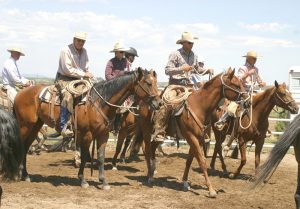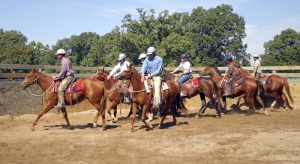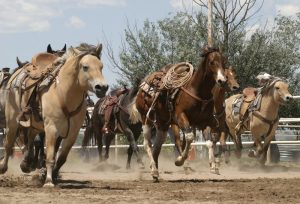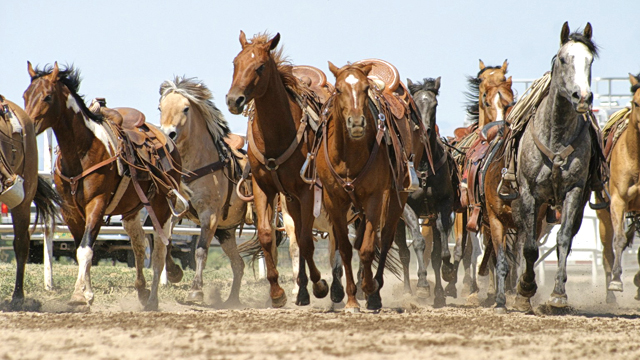This article originally appeared in issue No.30
A post on an Internet discussion group for dressage riders:
<<Help! One of my students has a green three-year-old colt that she has just started riding. We’re working in the indoor arena. The colt goes fine for about 30-40 minutes, but then he just plants his feet and balks. We can’t get him moving again. Any suggestions? >>
This post drew dozens of responses, ranging from unenlightened to vulgar, such as these:
• “It sounds like he needs a ‘come to Jesus meeting.’ Try kicking and then go to the whip, down low on the hind legs (most could care less if you hit them behind your leg or on the top of their croup, so be VERY sure you know where your whip is hitting the horse, most people don’t know). Keep whipping and kicking until he moves forward.”
• “Kick and then kick harder. Even the most dead-sided horse will get it eventually. If you have to, take your feet out of the stirrups and boot him HARD. MAKE him. Yes, it’s exhausting.”
• “You just have to have the attitude of SORRY PAL BUT THIS IS YOUR JOB NOW and I AM NOT GIVING UP AND I AM NOT GETTING TIRED.”
One poster rationalized the harsh prescriptions by saying, “If that sounds bad, well, that’s young horses for you.” The premise was that young horses, who cannot yet read our minds and know our intentions, ought to be bullied for their lack of understanding.
This, on a national dressage bulletin board. It was curious, and sad. This young horse is just learning about what life holds for him as a riding horse, and all these “classical” riders are chomping at the bit to offer him physical violence and tyranny.
I hoped the poster would recognize this advice as primitive at best, leaning toward vindictive. These strategies might get the colt moving, but without regard for WHY he was reluctant to move in the first place, HOW he feels about moving now, and the implications for the rest of his life’s relations with humans— whether those relations will be seen as friendly partnerships or hostile takeovers.
In a follow-up post, the trainer reported that she had tried the popular advice, and her student got pitched off. The colt still balks.
Why didn’t the traditional advice work? There are several likely reasons:
 Kicking doesn’t mean “go” to a greenie.
Kicking doesn’t mean “go” to a greenie.
The Baucherist horseman, Jean-Claude Racinet, says, “It is absurd that we call the legs a ‘natural’ aid and the whip an ‘artificial’ aid, because to the horse, it is the other way around.” As Mr. Racinet explains, even a completely uneducated horse will naturally move away from the action of a whip, but he will be more inclined to slow or balk when kicked with the leg.
Curt Pate speaks of how typical leg actions—squeezing, tapping or kicking—tend to turn the green horse’s focus backwards rather than forward, and can actually cause him to stiffen up and brace in discomfort or alarm, rather than flow forward.
It makes perfect sense. When you kick a horse in the ribs, he would naturally tighten his abdominal muscles to protect himself, just as you would do if someone prodded you in the sides. Even a polite squeeze or tap would turn the horse’s focus inward to his center rather than forward to your destination.
Only after the human has conditioned the horse to respond to the leg aid does it mean “go.” Taken at face value, the signal really means “wad up and prepare to defend yourself against discomfort.”
That’s what my own filly told me, before I was ready to hear it. It was Day Three of my first Buck Brannaman clinic, and I was in the colt class with my Dutch Warmblood. The whole group had just been turned loose in the big arena and invited to walk and trot around on a loose rein.
Lindsay was sluggish. I pushed her to sustain a walk, pushed more to coax a few dull strides of trot. Then she stopped and balked. So I did the only thing I knew how to do: I kicked her.
Thump…. thump. Nothing. Thump… thump. Nothing. Lindsay just stood there, stoic and unmoved, bunched up in much the way Curt described. It was frustrating. The other horses were trotting around on cruise control; why was my filly stuck in “neutral”? In that simple gesture of planting her feet, my greenie revealed what I didn’t yet acknowledge: “Kicking doesn’t necessarily mean ‘go.’”
Ineffective kicking confirms the balk.
Everybody who has ever been on a horse, even if it was just an hour on a rental horse, knows what it’s like to kick and kick and not be able to get the horse to go. It doesn’t take a horse long to figure out that he doesn’t have to go, unless your kicking becomes so offensive that going is the lesser of two evils, for now. The horse might go, but probably with a bad attitude.
If the horse gets a lucky guess as to what his rider wants, and moves out on the 10th kick, it might be tempting to say, “The horse learned that when I kick, he must go.” But the horse also learned, “When my rider kicks 9 times, I don’t have to go.”
 Coerce the “go,” and you might get more than you bargained for.
Coerce the “go,” and you might get more than you bargained for.
A few days after that first clinic, on our first trail ride, my filly balked again, and I repeated the same almost instinctual mistake. Thump, thump. I figured I could kick her through it, and she would learn once and for all to respect my leg. Ha! When her feet did get freed up from that balk, they whirled in a brisk spin that flung me to the ground in less than one revolution.
She simply did what was logical for her. Get relief from the kicking. It worked. My approach to her dilemma had been pretty crude, and I had failed in keeping her (and ultimately me) out of trouble.
Insistence can create resentment.
NP said it beautifully on that dressage forum (emphasis mine):
<<While there is no such thing as too much (correct!) forward, it is very possible to be going about asking for it in a very unproductive way.>>
Telling the horse, “You must, because I said so,” can actually create the sullenness that we think we are overcoming.
The request, “Go forward, horse,” isn’t the first step.
We often assume that the message, “Go forward when I squeeze my legs,” is self-evident. But it isn’t. To the horse, the basic level of the skill might be, “Move your feet in response to my messages, and you will faithfully be rewarded.”
The balking colt might say he doesn’t believe this, even on the ground. When driving out in the round corral, how does he look? Does he move out freely forward on a subtle, non-contact, non-threatening invitation? Or does the handler have to threaten him with a twirl or swack of the halter rope or a swish of the flag?
When he does move out, does he go smoothly, with a pleasant expression, or does he burst impulsively, perhaps with his ears flipped back, or a switch of the tail, snaking his head, haunches turned in, hip kicked up with a bit of an “up yours” message?
The colt in our original post would probably fit the second picture. He might be saying, “I’ll go, for now… but I’m not happy about it, I don’t see any purpose in it, and I don’t foresee much expectation of payback.”
What does work, then, to get the green colt to go?
Kicking the stuffing out of a young horse might make him so uncomfortable that moving forward is the lesser of two evils. But is that how we want to interact with horses? We can gain better progress and more willing relations by improving our awareness, timing, and tact— rather than the PSI force of our kicks.
Check out the “go” in groundwork first.
If the horse doesn’t flow willingly in groundwork, he probably won’t flow under saddle either. Forwardness-on-request requires a free and willing mind in the horse. That means whatever softens the horse’s mental state, removes brace and frees up his feet will in turn enhance his forwardness.
What if the horse moves out resentfully in his groundwork? Experiment with doing less and releasing more. A few years ago I worked with a mare that a professional trainer had labeled as “lazy” with “no work ethic.” I could see the trainer’s concerns. Initially, the young mare worked begrudgingly. When asked to trot out in the round corral, she clamped her lips, swung her head, pinned her ears, switched her tail and kicked up.
I soon realized that, rather than being dull or inattentive, the mare was quite sensitive and aware. She read small nuances of body language from 50 feet away. Perhaps she was so keen to a whisper that the other handler’s normal actions seemed to her like rude shouts?
Testing this theory, I backed way down in my signals and gave her the benefit of the doubt. I asked first with visualization and focus, following up with subtle, non-threatening invitations. I gave her extra seconds to volunteer, before stepping in with a bigger signal. I wanted her to feel that my requests were politely asked, rather than demanded and commanded.
That simple strategy—allowing the mare to volunteer rather than making her comply—made all the difference. The mare’s attitude got softer throughout the weekend, and her freed-up attitude led her to be ever more forward.
 Do as little as possible, only as much as it takes.
Do as little as possible, only as much as it takes.
A green colt with good groundwork basics is very attentive even on the first ride. Why not start right then preserving and enhancing that lightness, rather than assuming he’ll be crude and riding him as such?
At a Bill Scott clinic last year, I focused on this philosophy for the first rides on an Oldenburg filly. From the start, I tried to use the most subtle cues possible to ask her to go. Every time I wanted her to walk or trot out, I followed this
progression:
(1) Visualized what I wanted, pictured her stepping off in the desired gait.
(2) Brightened the energy in my body.
(3) Took weight off my pockets and got lighter in the saddle.
(4) Activated my upper calf in a way that was invisible to an observer.
(5) Gave the filly a few moments to consider these messages, and only then, only if 1-4 hadn’t produced the result, then…
(6) Squeezed or tapped her with my legs, and only if this had no result, then…
(7) Patted my chaps, “ch-ch’d” or wriggled my legs more vigorously.
That filly, being completely new to the riding experience, started out her first ride quite dull. She moved sluggishly forward one dreary step at a time and stalled easily. How tempting it would have been to jump to #6 or #7 above, because I know for SURE that 1-4 would have no result!
Yet by my being faithful to this progression, the filly quickly learned to listen to ever more subtle signals. After all, she wanted the good deal too. She would be happy to avoid a big or “noisy” signal if she just knew how. You could see her figuring it out a little better each try, a little better each ride. By her fourth little ride, she was moving freely into a walk and trot on signals that were invisible to any observer and effortless for me.
Did I sometimes have to follow up with #6 or even #7? Sure, but never without offering 1-4 first. Now, a cynic might protest: “The just-started colt doesn’t understand aids as subtle as 1-4, so why do it?” The answer is that he will learn it very quickly—starting in that first ride—if we offer it. He will not learn it if we don’t. We could start offering finesse on the 10th ride if we wished, but we would just be 10 rides behind where we could have been.
Since this filly is destined to be an upper-level dressage horse, it made sense to calibrate the go-forward aids toward maximum ease and lightness from the very first ride. If it doesn’t require a squeeze with the legs to ask for a walk, trot or canter, then that degree of signal remains available to someday sustain a much bigger “get up and go” request, such as for canter pirouette or piaffe.
Resist the temptation to push for more.
In my opinion, this advice is the hardest to follow, but the easiest path to success: don’t nag. No matter how tempting it might be to push-push to maintain movement, it works better to allow rather than force… to give the horse a chance to volunteer.
Mr. Racinet calls this a state of “liberty on parole.” I call it making myself invisible when everything is going right, even if just for the moment. There has to be some clear reward to the horse for going forward freely. What incentive would he have to be forward if we immediately took his forwardness for granted and pushed for more?
So, when a green colt obliges me by going forward, I’ll immediately stop whatever I was doing to ask—whether it was #1 or #7 on the “please go” scale of requests. That’s a clear “thank you” to the horse. If the horse then slows or stalls, I’ll ask again and show gratitude (release the aids) again.
It is nearly impossible to resist the temptation to push-push-push to keep that dull greenie moving, but if I can resist that temptation, I find that I get what I want—equine cruise control—much sooner than if I push to get it.
If I were to nag (the almost universal human tendency), I’d be telling the horse, “When I asked you to move, and you moved, that was squat. I’m not happy with that. Keep searching for some different answer.” However, if I released for that first try, I’m telling the horse, “When I asked you to move, and you moved, that was great, exactly what I wanted!” Watch how quickly the horse responds by saying, “If you think that was great, see how much more I can volunteer next time!”
Address a balk before it happens.
If we’re listening carefully, the colt usually tells us he is about to stop, several strides before the motor stalls. That’s the time to do something different, break the pattern, and keep the horse with us mentally.
There’s no need to let the horse blunder ahead into being wrong, when we see it coming, just so we can kick him out of it. If my mount got all the way to a full-fledged quit, I missed the boat; I wasn’t aware enough, and I missed an opportunity to sense it shaping up and shape it up differently.
Step the hindquarter laterally, do a touch of “soft feel,” rub him vigorously on the neck, pat him on the rump, swish your legs like you’re walking, do a one-rein stop, step the forequarters across, back up a few steps, walk over cavaletti… any of these things can break the pattern and keep the horse with us mentally, without unkindness.
“Movement creates movement,” says Curt Pate. He demonstrates that the green colt becomes more forward if the rider simply creates some movement in himself, such as “walking” his arms and legs back and forth without slapping or kicking.
If you can’t get forward, get lateral.
Anyone who has tried to drive a reluctant horse forward knows that horses figure out quickly that they don’t have to go, no matter how much force is applied. In contrast, it doesn’t take much effort (and it can be quite smooth and elegant) to free up the feet of a stuck horse by using deep lateral work.
Put one leg behind the girth, apply a light but perceptible pressure (later that will be just a presence with no pressure). If the horse doesn’t disengage the hindquarters, come in smoothly with the inside rein. Draw (not bump) the inside rein around to your thigh to invite a deep lateral bend of the head and neck. The instant the horse steps laterally behind, immediately release the leg and rein. If the horse now volunteers to step forward, even a bit, float with it and stay out of his way. If he doesn’t, just gently repeat in the other direction.
How do we know the horse will step laterally behind? Horses naturally want to be straight; if you put them in a position of being bent, they’ll reposition themselves to get straight every time. When we trigger movement in this way, the horse never learns what a helpless weakling the human really is, that we could be stuck flailing our legs to no effect.
Closing thoughts
Most folks on that Internet discussion group took the view that the balking colt was lazy, stubborn, nappy, trying to get the upper hand on the human. More likely, though, the colt was confused, defensive, sure that the other shoe was about to drop anytime (whether it was or not), and trying to get along and protect himself the best he knows how. That calls for assurance, encouragement and appreciation for efforts in the right direction—not punishment and coercion.
Why does the colt not want to go forward? Does he not understand? What has been done to make it unrewarding for him to go forward?
When a greenie seems stuck or dull, the answer might be in small details. Maybe we’ve assumed he was going to be dull, and rode him in a heavy-handed way that he found disagreeable. Maybe we are ordering him to do what he would gladly have done anyway, and in the process we stole his chance to cheerfully volunteer. Maybe he sees no payoff for going, only sees escalating demands with no gratitude.
If the horse’s attitude is important, we won’t get far if our own attitude is, “SORRY, PAL, BUT THIS IS YOUR JOB NOW.” Our job as humans is to figure out what the colt is missing and how to secure his cooperation.
Subscribe today for more helpful horsemanship articles.
[ux_custom_products cat=”magazine-subscriptions” products=”” columns=”4″ title=””]


